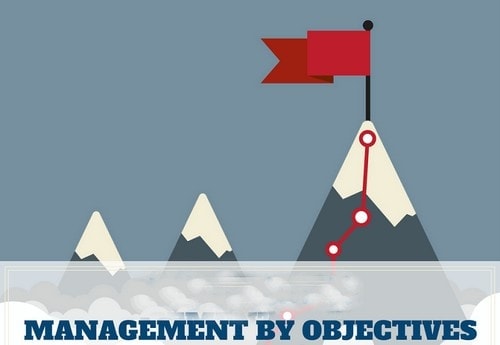
MBO: Steps, Benefits, and Drawbacks

Management by Objectives (MBO) is a strategic approach aimed at enhancing organizational performance by defining objectives and creating a system of feedback and evaluation This article will explore the steps involved in MBO, its benefits, drawbacks, and the conditions required for successful implementation
Understanding the concept of MBO
Management by Objectives (MBO) is a powerful and popular strategic management approach that aims to enhance organizational performance by setting clear and measurable objectives. It is also sometimes referred to as Management by Results (MBR) due to its focus on achieving specific outcomes.
Management by objective was introduced by Peter F. Drucker in his book "Practice of Management" in 1954. It is a personnel management model that aims to improve an organization's performance by having employees and managers collaborate to set and achieve specific objectives within a defined timeframe.
When an organization sets a specific goal and plans out the necessary actions to achieve it, Drucker's technique suggests that employees are more likely to become fully dedicated and engaged in the work. This approach also helps to ensure that everyone is working towards a common objective. Ultimately, the success of this model hinges on effective planning.
The MBO approach involves setting clear goals and objectives, which are then pursued collaboratively by all members of the organization. This management model emphasizes both the role of supervisors and the contributions of subordinates in achieving the desired outcomes for the organization. The process is highly structured and closely managed to ensure the best possible results.
The individual responsibilities of each employee are specified to ensure clarity and avoid confusion, ultimately resulting in the efficient operation of the unit through the honest contributions of all team members.
The objectives established by this model are continuously monitored until they are successfully accomplished. This ensures regular progress checks and allows for necessary improvements to be made. Additionally, rewards are given based on the level of achievement of these goals.
Rewritten: Management by objectives is a management system that enables organizations to compare their actual performance with previously defined achievements. This system is beneficial in boosting employee motivation as they are provided with a target to strive for and a thoughtfully prepared action plan to follow.
Encouraging employee commitment and improving communication with management are key benefits of implementing principles based on MBO, as outlined in the book that inspired this concept. To effectively achieve challenging objectives, regular feedback is crucial and a focus on rewards rather than punishment is emphasized for employees.
More emphasis is put on personal growth and development. In this way, Drucker proposed the MBO as a tool that would do a lot of benefits to the organization.
What are the different conditions that must be met for the management by objectives (MBO)?
Now before we have a look at the conditions that are required for the MOB, let us first take a look at the assumptions that are made for the management by objectives.
MBO approach to be successful. Firstly, it is essential for the goals to be specific, measurable, achievable, relevant, and time-bound. Secondly, the goals need to be communicated effectively to the employees so that they have a clear understanding of what is expected of them. Lastly, it is important to provide regular feedback and support to the employees to help them achieve their goals and improve their performance.
The employees of an organization play a crucial role in defining its main objectives. Typically, these objectives are established at two levels - qualitative and quantitative.
Having challenging and motivating objectives can lead to better results in any endeavor.
Instead of relying solely on static management reports, daily feedback is provided at various coaching levels to track progress and development.
The main principle is based on growth and development and not on the punishments.
What are the steps involved in MBO?
The MBO process involves employers and managers working together to manage subordinates by setting and striving towards targeted objectives that benefit both employees and the company. The focus is on continuous work towards achieving these goals.
Now mainly there five steps involved in management by objectives (MBO) which are as follows-
Reviewing the organizational goals
Setting the objectives for the workers
Constantly keeping a check on the progress by monitoring it regularly
Evaluation of the work done
Giving out rewards on the successful completion of the work.
Now lets us discuss all of these steps in detail
The organization's objectives are first identified and, in some cases, reevaluated for the entire company. This comprehensive assessment is guided by the company's vision and mission. Next, the organization's objectives are translated to ensure that employees have a clear understanding of the company's concepts and perspectives.
Individual objectives are set in the third step to simulate the simulation, with the aim of achieving a common final objective. In the fourth step, each employee's progress is monitored and recorded for future reference.
And in the fifth and the last step, the entire process and its results are evaluated, and then the managers and the employees of the workforce are rewarded accordingly.
Advantages and Disadvantages of MBO
Advantages of MBO
Now there are countless distinct advantages of the management by objectives. Out of which some of them are discussed below-
By providing a clear understanding of their roles and responsibilities within the organization, this tool allows employees to perform their tasks and duties more effectively. It is especially useful in creating customized Key Result Areas (KRAs) for each employee, based on their individual interests, experience, and areas of expertise. This helps to eliminate any confusion they may have about their specific duties and tasks, ensuring that they are able to perform at their best.
Fragment 25 rewritten:
The MBO allows all employees in the organization to contribute towards achieving the set objectives by fulfilling their assigned tasks and duties under the supervision of their superiors. Regular feedback and revisions are provided to employees, promoting open communication and better coordination. This is facilitated by healthy interactions among employees working together in the organization.
Clear goals are emphasized to prevent misunderstandings. This approach fosters employee motivation, resulting in increased productivity and job satisfaction, as well as a stronger commitment to their work.
By utilizing MOB, managers can guarantee that every subordinate is aligned with the management's directive principle. This not only enhances communication and accountability but also promotes a sense of unity among employees towards achieving a shared organizational goal. The result is improved productivity and performance.
Also, the MBO avoids any kind of confusion or the overlapping of the duties and the task of the individual employees.
Disadvantages
Despite the numerous benefits of management by objectives (MBO), there is one disadvantage that cannot be overlooked. MBO tends to overemphasize the importance of the goals set, sometimes at the expense of other important factors.
The MBO generally unduly emphasizes the attainment of the objectives and does work on a systematic plan for the same.
Here is a video byon Management by Objectives.
Conclusion
Effective implementation of the management by objective (MBO) model is crucial for organizations to unlock the full potential of their employees and managers. By keeping the organization's objectives at the forefront of their minds, individuals can work towards achieving the desired goals and ultimately drive success for the organization as a whole.











